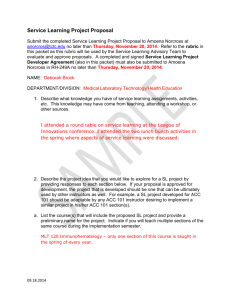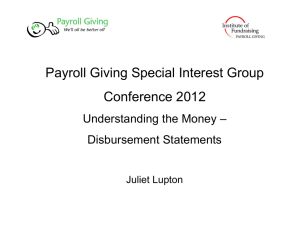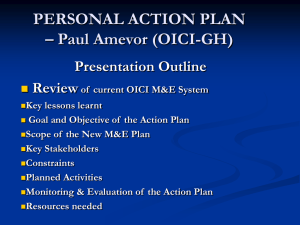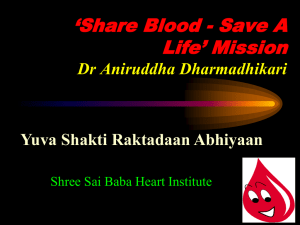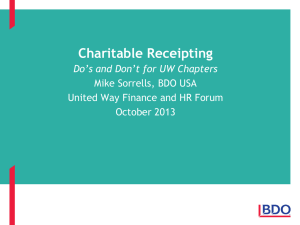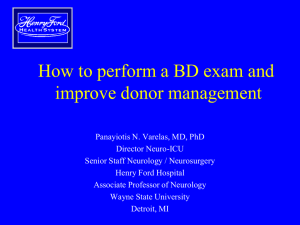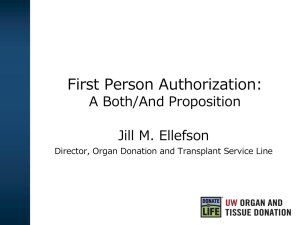Lifesharing Tissue Bank
advertisement
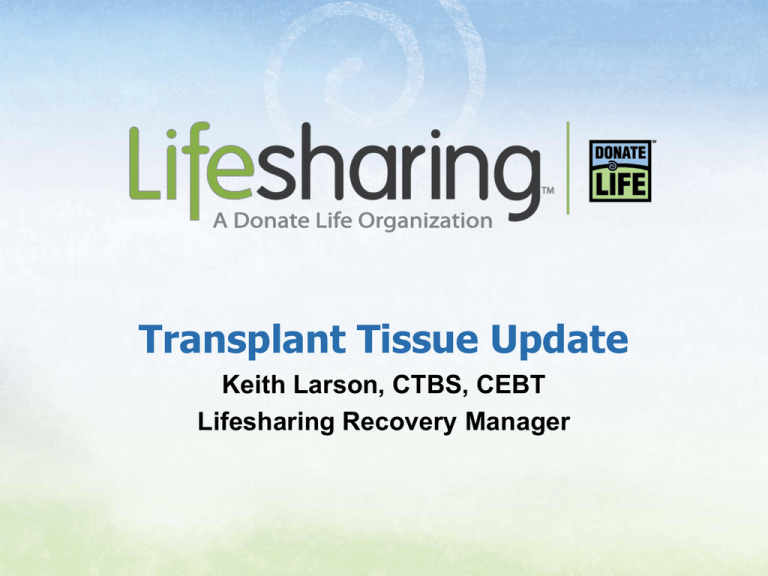
Transplant Tissue Update Keith Larson, CTBS, CEBT Lifesharing Recovery Manager Lifesharing • Founded in 1984 as a Division of UCSD Medical Center • One of 58 Regional Federally Designated Non-Profit • • • • • • OPO and Tissue Recovery Bank Affiliated with 26 donor hospitals and 4 local transplant centers in San Diego/Imperial Counties 1,700 San Diego patients/112,000 patients nationwide Work closely with 2 Medical Examiners offices, Funeral homes, Nursing homes, Hospices and local San Diego Eye Bank Most of the Tissue recoveries take place here at the MEO-Lifesharing has a dedicated Recovery Suite. Lifesharing has approximately 60 employees RN's/Tissue Recovery Staff are Unionized What is Tissue Donation and why the need: • Over 20,000 deaths annually • 9.8 registered DMV potential donors • Lifesharing recovered 420 Tissue Donors last year • Approx 1,500,000 allografts transplanted worldwide each year for a variety of life-saving and life-enhancing surgeries: • 36 million Americans with debilitating musculoskeletal conditions who could benefit from an allograft. • Partner with 7 different Tissue Processors (i.e. Allosource, Lifecell, LifeNet, MTF, etc). Also store/distribute frozen/freeze dried grafts for some of these tissue processors here in San Diego. • Partner with UCSD Whole Body Donation – donor can be a tissue and whole body donor Referral to Recovery-Non MEO Imminent Death / Death Occurs Recovery takes place Lifesharing is notified Full Review Initial review Authorization is confirmed / obtained. Lifesharing is Notified of Death Patient Chart is needed Anyone can Call 888 – 4 A DONOR 888 423-6667 What the Hospital Staff will initially need to provide to Lifesharing: •Basic info •Your Name & Title •Hospital , Unit & Floor •Call Back number •Patient Info •On a vent? Heartbeat? •Name of Patient •Age of Patient / Date of Birth / Race / Gender / Weight •Date of Death / Time of Death •Cause of Death •Medical Record Number •Admit Date •Medical Examiner Case •Location of Body •Next of Kin Information •Medical Screening •HIV Hepatitis B / Hepatitis C / Cancer / Dementia / Sepsis Provide a Referral Number Inform you who will be notified and will call you back Initial Review DO NOT APPROACH FAMILY ABOUT DONATION! Lifesharing or SDEB will call back to confirm information and ask additional questions to determine suitability • Cancer questions • When diagnosed? • Treatments? • Physicians? • Sepsis • Cultures? • WBC’s • Chest X-Rays? • Next of Kin information • Status • Phone number to reach them • Language barriers Consent is obtained via telephone / in person Hospital is notified of outcome • Body will be transported to our recovery suite • Body will be released to funeral home Authorization is confirmed / Obtained Legal Next of Kin is given Option of Donation or advised of Registration Support is given whether family decides to donate or not to donate High Risk Assessment is obtained Determination of suitability is established for next level of review or Donor is “shut down” If A MEO Case: • Lifesharing and the San Diego Eye Bank review the MEO death reports twice a day. • If a potential donor then NOK is contacted by a Family Services Coordinator • If NOK gives authorization, and the case is a possible Autopsy case, then the MEO investigator is contacted and a Pre/Post Autopsy request form is faxed. • Then once authorization is received either Lifesharing or the San Diego Eye Bank we evaluate how to proceed with tissue recovery. Recovery Body is transported to Lifesharing recovery suite Physical Inspection is done Authorization/Medical Soc is reviewed Blood drawn for serologic testing for HIV, HBV, HCV, RPR Recovery of donated tissue is conducted by trained professionals Tissues Recovered Corneas Costal Cartilage Heart for valves Mandible Humerus Ribs Vertebrae Elbow Radius/Ulna Ilium Femur Fascia Femoral V/A Patellar Tendon Tibia Saphenous vein Fibula Ankle Tibialis tendons Tissue Uses Mandible/ Hemi Mandible Cancellous Chips Wedges, Dowels, Chips Whole, Proximal, Chips, DBM Elbow, Whole Joint Fascia Proximal/Distal, Dowels, Heads, Shafts, Chips, DBM Shaft, Chips, DBM BTB, Proximal, Dowels, Chips, Shafts, DBM, Hamstrings Ankle, Whole Joint Tissue Uses: Applications: Benefits: Bones: spinal fusions, congenital defects, reconstruction due to trauma, cancer, tumors, disease & fractures Restores appearance, mobility & decreases pain, prevent amputation Tendons: replacement ACL, PCL, Achilles tendons. Restores Mobility Skin: grafts for burn victims, abdominal wall repairs, hernia repair, pelvic floor reconstruction, facial reconstruction, breast reconstruction following mastectomy. Promotes healing, reduces scarring and restores abdominal wall. Blood vessels: replaces damaged arteries and veins. Increase circulation, limb salvage Heart valves: replaces damaged or defective heart valves Improve heart function, allows a child to grow into graft Specialty Grafts • Right 5th Metacarpal and 1st Phalange –to repair • • • • finger of a 15 yr. old girl who suffered a traumatic injury playing soccer-recover from a male/female between the ages of 15-45 yrs-no autopsy Rt/Lft Elbow En-Bloc-male donors, no autopsy Shoulder, Clavicle, Humeral Head Tremendous need for Infant Heart Valves and Juvenile Cartilage grafts-Full Term Birth to 13th birthday With some grafts No autopsy because some grafts are processed fresh and released +/- 21 days. They are mixed w/stem cells to expedite bone growth. Used for sports medicine injuries! Skin Recovery Dermatome Recovery Freehand Graft Recovery Improved Surgical Repair Ruptured Omphalocele Courtesy Dr. Schrupp Placement of Acellular Dermis Wound Closure Co-joined Twins Acellular Dermis Silos Top LifeSharing Hospital Tissue Usage: 2009 - 2011 Hospital Total Grafts Donors Needed Scripps Memorial Encinitas 942 140** Scripps Memorial LaJolla 1007 43** Sharp Memorial 663 44 Grossmont District 1343 62 Kaiser San Diego 653 17 The Facts Donor families incur no expense for donation Donation is consistent with the life-preserving traditions of most major religions Donation is a sterile aseptic procedure. Open casket funeral are possible-anyone can be a eye donor for Tx or Research You do not have to match blood, age or gender to be a tissue donor Tissue cannot be bought or sold Donor families tell Lifesharing donation makes sense out of tragedy and helps their grieving Follow -Up • Follow-up letter is sent to the NOK to inform them if the donation took place or not. • We offer twice a year a ‘Day of Remembrance’ at a local funeral home for the families who donated. • Sometimes the donor families may want to meet the recipients of Organs donated. THINGS TO CONSIDER Do not rule patient out as donor candidate before calling the Donor Referral Line “1-888-4A-DONOR” A Lifesharing Coordinator will discuss options when timing is appropriate. Communication is key – Keep us informed if a Family Member wishes to donate! Remember… One organ and tissue donor can save the lives of 8 people and enhance the lives of 60 people Questions? What is Tissue Donation and why the need: • Surgical recovery of donated tissue for safe and sterile transplant into a recipient • Approx 1,500,000 allografts transplanted each year for a variety of life-saving and life-enhancing surgeries: • 36 million Americans with debilitating musculoskeletal conditions who could benefit from an allograft. • Partner with 7 different Tissue Processors (i.e. Allosource, Lifecell, LifeNet, MTF, etc). Over 20,000 deaths annually 420 tissue donors last year



